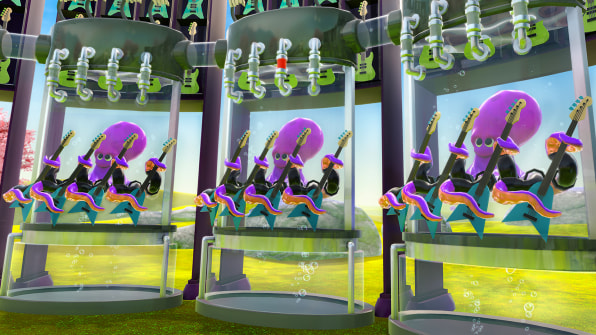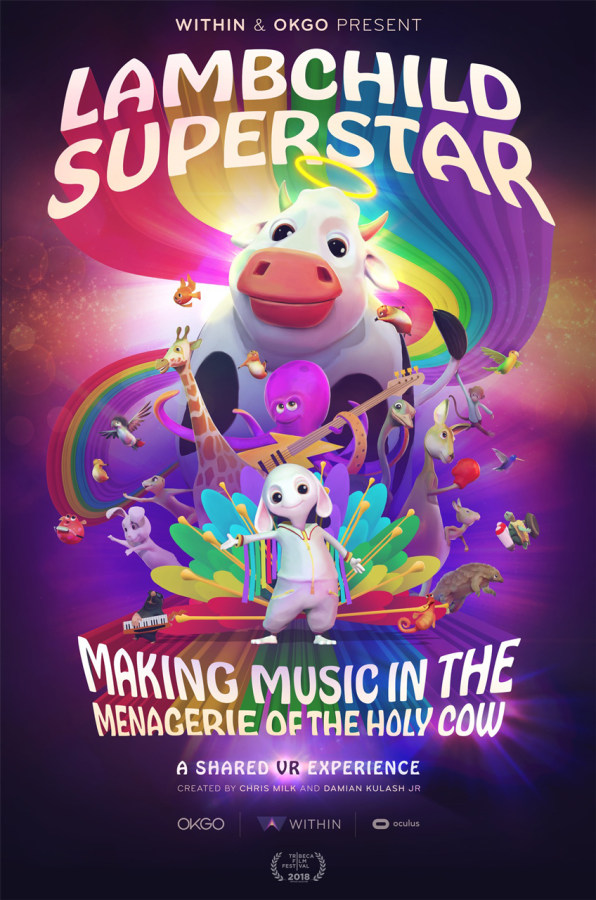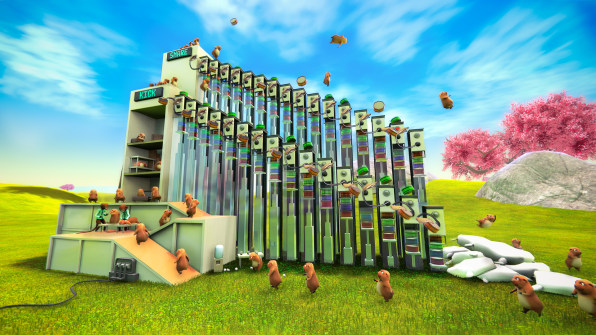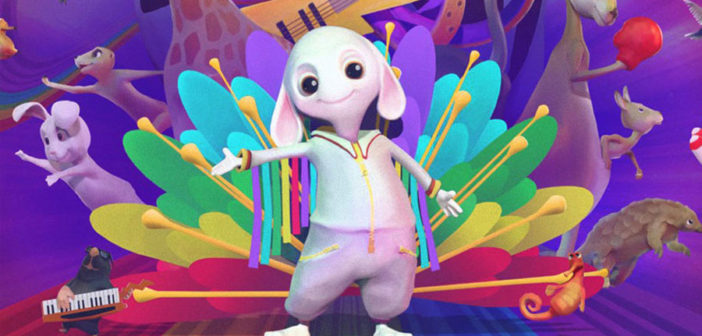Lead singer and guitarist Damian Kulash and I made beats using lemmings and chords using puffer fish.
I’m standing in a meadow. Suddenly, Damian Kulash, the charismatic lead singer and guitarist of the rock band OK Go, appears next to me in the form of a giant lamb with rainbow streamers protruding from his arms. We meander around the meadow, playing synthesizers connected to hybrid musical instruments that are themselves powered by animals: lemmings jump off cliffs to power snare drums, blowfish play mini harmonicas, and electric eels light up an electric guitar (obviously).

This is Kulash’s latest creative experiment, called Lambchild Superstar: Making Music in the Menagerie of the Holy Cow. It’s a VR experience that lets you and a friend make music together by conducting a giant orchestra of wacky animated animals. To partake, Kulash and I have donned Oculus Rift VR headsets in curtained rooms at the Tribeca Film Festival‘s Virtual Arcade in New York, where we discuss which beats to drop and chords to add via a microphone as we’re transported to a musical playground.

For a guy who has become famous for creative music videos–the last of which featured 557 printers simultaneously spitting out colored pieces of paper as the band played in front–it’s perhaps his most audacious feat yet. OK Go has always used technology to push the boundaries of what it means to make and market music in the 21st century, with videos that use Rube Goldberg machines and zero gravity for wild visual effects. VR was a logical next step. Kulash teamed up with the renowned VR producer Chris Milk, to create Lambchild Superstar.
Dropping down into the so-called Menagerie of the Holy Cow experience is a bit disconcerting. But with Kulash as my guide, we walk over to the lemmings-powered drum kit and select beats. I’m a bit shy in front of such a musical powerhouse, and he quickly puts together a simple beat upon which we can build our song. As we’re playing with the controls in front of us, a giant colony of lemmings goes to work, scurrying up to the top of a long series of columns and then hurling themselves off, landing on particular drums based on the beat we’ve designed for them. They end up in a pile of pillows at the end of the columns; from there, some go get a massage, others watch TV, and one unlucky lemming gets a talking to from the big boss, who perhaps is unhappy with his flinging form.
As we play around, it quickly becomes clear there’s no right way to make music here. After setting up a beat with the lemmings, Kulash guides me around the rest of the menagerie, where we play with a boxing kangaroo that adds a triangle ting to our jam session and hang out with a bunch of blowfish playing harmonicas that we use to pepper the song with chords.

For the blowfish instrument in particular, there’s a lot going on in the background. Milk tells me that he and his team analyzed 40,000 of the most popular songs from the last few decades to help people determine what chord progression you want to use. After you pick your first chord, the next options will be a range of different-sized blowfish, where the puffer’s size correlates to how heavily used that chord progression has been in pop music. For instance, a big red blowfish might represent a Britney Spears-style chord progression, while a tiny purple blowfish is likely from songs that are more alternative. “It seems like a magical silly fairy tale, but on the back end it’s like a supercomputer of music theory and AI and machine learning,” Milk says.
You don’t have to know any of this in the Menagerie of the Holy Cow–you just groove. We stand at an imaginative instrument that slingshots armadillos into a room where the rolled up creatures bounce off penguins’ shields, adding a new layer of synthetic sound that doesn’t seem to correspond to any specific instrument. Kulash picks a beat and I adjust by literally picking up the penguins and moving them around the room. After a few tries we hit on something that sounds kinda funky and clicked into place. The music production software that undergirds everything is working to give you choices based on what’s been done before, providing a menu instead of forcing you to create everything from scratch. It takes away the stress and self-consciousness that can come with making music (something I suffer from in droves). It’s also intuitive.
After we decided the song was done, Kulash and I jogged back to the center of the meadow and hit a “play song” button. All the animals started dancing at once. Kulash’s lamb character sprouted tail feathers like a peacock and we danced around in the menagerie. Then, it was time for a solo: I went over to the titular “holy cow,” lifted its tail, and allowed its magical flatulence, shaped like a giant bubble, to waver up and down at my command. Kulash stood in its path and grooved as the bubble washed over him and confetti came down from the sky.
For Kulash and Milk, the goal is to let anyone, regardless of ability, access the feelings they have when they create something; the experience will be in private beta on Milk’s company Within’s VR platform soon. And Kulash’s experiments in Lambchild Superstar have actually led to some new musical ideas. In that moment, I felt it too: the joy of making something I could call my own–with a little help from some lemmings and a farting cow.
–
This article first appeared in www.fastcodesign.com
Seeking to build and grow your brand using the force of consumer insight, strategic foresight, creative disruption and technology prowess? Talk to us at +9714 3867728 or mail: info@groupisd.com or visit www.groupisd.com




